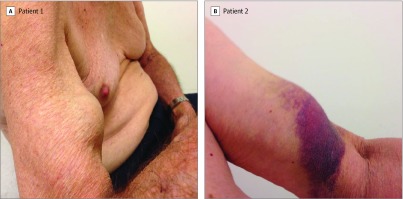Abstract
This cross-sectional study compares the frequency of rupture of the distal biceps tendon in patients with wild-type transthyretin amyloidosis cardiomyopathy vs those with other causes of heart failure.
Wild-type transthyretin amyloidosis (ATTRwt) is increasingly recognized as an important cause of heart failure with preserved ejection fraction (HFpEF), affecting 13% in a consecutive series of cardiology and internal medicine patients admitted to a university hospital. However, the diagnosis is often not considered due to the perceived rarity of the disease. Although the primary manifestation of ATTRwt is cardiac, approximately 50% of patients have a history of carpal tunnel syndrome, with amyloid deposits in the flexor tenosynovium.
Spontaneous rupture of the distal biceps tendon (RBT) is uncommon, with an estimated prevalence of less than 1 per 1000 persons aged 56 to 74 years. We observed RBT in several patients with ATTRwt cardiomyopathy, and performed a cross-sectional study to further evaluate.
Methods
From December 2013 through January 2016, all patients with ATTRwt cardiomyopathy presenting to the Cardiac Amyloidosis Program at Brigham and Women’s Hospital were systematically evaluated. The diagnosis of cardiac ATTRwt was based on histopathology of endomyocardial biopsy or positive result from technetium pyrophosphate scanning in the absence of a plasma cell dyscrasia. Genetic testing was conducted to exclude mutant ATTR amyloidosis. Patients were asked about symptoms of RBT, date of onset, and associated trauma. RBT was defined as bunching of the biceps in a “Popeye” fashion (Figure) upon flexion of each arm against gentle resistance. A control population of 40 age-matched patients with common non-amyloid etiologies of HF was recruited from January 2017 through March 2017, and included patients with HF with reduced EF or HFpEF and ischemic, hypertensive, valvular, or dilated cardiomyopathy. Consent was obtained verbally; the Partners Healthcare institutional review board approved the study. Association between RBT and ATTRwt was examined using the Fisher exact test, with a 2-sided P value of less than .05 for significance. Analyses were performed with Stata (StataCorp), version 14.2.
Figure. Examples of Ruptured Biceps Tendon in 2 Patients With Biopsy-Proven ATTRwt Cardiac Amyloidosis.
ATTRwt indicates wild-type transthyretin amyloidosis. A, Patient with prior rupture of the biceps tendon and bunching of the biceps with flexion. B, Patient with acute rupture of the biceps tendon in the left arm. The tendon rupture occurred with trivial trauma, 5 years after cardiac amyloid diagnosis.
Results
Of 111 patients with ATTRwt cardiomyopathy (ATTRwt group; mean age, 74.9 years [SD, 6]; women, 3) evaluated, RBT was observed in 37 patients (33.3% [95% CI, 24.7%-42.9%]), occurring in the dominant arm in 35 patients (95% [95% CI, 82%-99%]) and bilaterally in 9 patients (24.3% [95% CI, 11.8%-41.2%]). Of those with RBT, 14 patients (37.8% [95% CI, 22.5%-55.2%]) were unaware of the onset or existence of RBT. In the remainder, RBT occurred a median of 5 years (interquartile range, 2.5-9.0) before HF diagnosis. The control group (HF group) included 29 men and 11 women with a mean age of 74.1 years (SD, 8); RBT was observed in 1 patient (2.5% [95% CI, 0.1%-13.2%]). This patient did not have echocardiographic features suggesting amyloidosis, but technetium pyrophosphate imaging was not performed. The proportion of RBT was significantly higher in the ATTRwt group than the heart failure group (Table). If the prevalence of ATTRwt in HFpEF is 13%, presence of RBT would have a positive predictive value of 66% (95% CI, 53%-77%) for the diagnosis of ATTRwt in a patient with HFpEF.
Table. Frequency of Ruptured Distal Biceps Tendon Among Patients in the Biopsy-Proven ATTRwt vs Heart Failure (Control) Groups.
| Ruptured Distal Biceps Tendon Status | ATTRwt Group, No. of Events (n = 111) |
Heart Failure Group, No. of Events (n = 40) |
|---|---|---|
| Present | 37 | 1 |
| Absent | 74 | 39 |
Abbreviation: ATTRwt, wild-type transthyretin amyloidosis.
Fisher exact test comparing ruptured biceps tendon prevalence in ATTRwt and heart failure group, P < .001.
Discussion
In this study of patients with HF, RBT was found in 33.3% of patients with ATTRwt and only 2.5% of patients with other causes of HF. Based on the histologic studies of tendons and ligaments in older patients, RBT may represent ATTR deposition in the biceps tendon, similar to carpal tunnel syndrome.
This study has several limitations. Recall bias may account for some error in estimating the onset of RBT, and histologic confirmation of amyloid deposition in the tendon was not available, but it is the presence of this finding, not the precise onset, that is important. The control group included HF patients with reduced and preserved EF, but the nature of the HF should not affect RBT. Precise estimates of the prevalence of ATTRwt as a cause of HF are lacking and would affect the positive predictive value. The study was conducted at a single referral clinic and the results should be confirmed.
Early diagnosis of ATTRwt is important because trials are under way investigating therapies to halt disease progression. The finding of RBT, an easily elicited diagnostic sign, in a patient with HFpEF should raise suspicion for ATTRwt. This observation underscores the continued importance of physical examination in an era of extensive diagnostic testing.
Section Editor: Jody W. Zylke, MD, Deputy Editor.
References
- 1.González-López E, Gallego-Delgado M, Guzzo-Merello G, et al. Wild-type transthyretin amyloidosis as a cause of heart failure with preserved ejection fraction. Eur Heart J. 2015;36(38):2585-2594. [DOI] [PubMed] [Google Scholar]
- 2.Connors LH, Sam F, Skinner M, et al. Heart failure resulting from age-related cardiac amyloid disease associated with wild-type transthyretin: a prospective, observational cohort study. Circulation. 2016;133(3):282-290. [DOI] [PMC free article] [PubMed] [Google Scholar]
- 3.Sueyoshi T, Ueda M, Jono H, et al. Wild-type transthyretin-derived amyloidosis in various ligaments and tendons. Hum Pathol. 2011;42(9):1259-1264. [DOI] [PubMed] [Google Scholar]
- 4.Safran MR, Graham SM. Distal biceps tendon ruptures: incidence, demographics, and the effect of smoking. Clin Orthop Relat Res. 2002;(404):275-283. [PubMed] [Google Scholar]
- 5.Gillmore JD, Maurer MS, Falk RH, et al. Nonbiopsy diagnosis of cardiac transthyretin amyloidosis. Circulation. 2016;133(24):2404-2412. [DOI] [PubMed] [Google Scholar]



